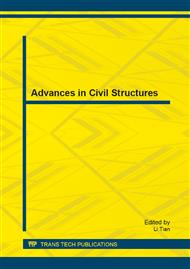p.910
p.915
p.919
p.923
p.927
p.933
p.939
p.945
p.950
Experimental Study on Relationship between Half-Cell Potentials and Load Carrying Capacity of Corroded Reinforced Concrete Shear Walls
Abstract:
This paper addresses the results of an experimental study on relationship between half-cell potentials and load carrying capacity of corroded concrete RC shear walls. There are four specimens in the test with the corrosion rate of 0%, 3%, 9% and 15%, respectively. Before and after the accelerate corrosion test, half-cell potential measurement was used to attain half-cell potentials. The horizontal load carrying capacity was attained under cyclic loading. Results show that load carrying capacity of corrosion damaged walls decrease with the increase of corrosion rate, as well as half-cell potentials. The relationship among corrosion rate, half-cell potentials and load carrying capacity is presented.
Info:
Periodical:
Pages:
927-932
Citation:
Online since:
August 2013
Authors:
Price:
Сopyright:
© 2013 Trans Tech Publications Ltd. All Rights Reserved
Share:
Citation:


